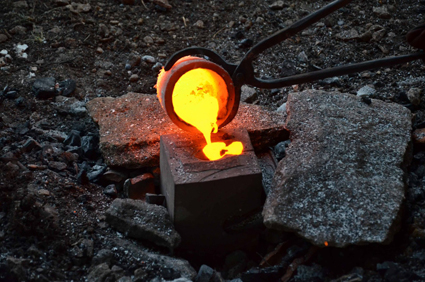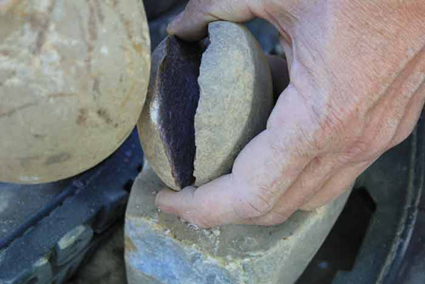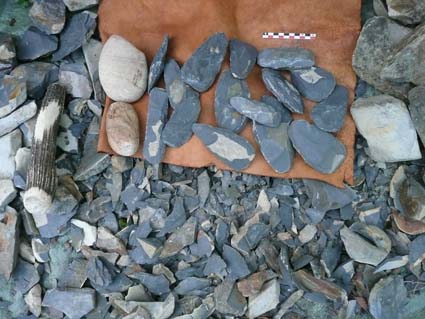"Il y en a trois qui font quelque chose.
Il y en a dix qui font des conférences sur ce que font les trois.
Il y en a cent qui font des conférences sur ce que disent les dix.
Il arrive parfois que l'un des cent vienne expliquer la manière de faire à l'un des trois.
Alors l'un des trois intérieurement s'exaspère et extérieurement sourit.
Mais il se tait car il n'a pas l'habitude de la parole.
D'ailleurs il a quelque chose à faire."
Marcel Jousse, anthropologue, 1978
"Ne rien dire que nous n'ayons fait"
Fernand Oury, 1970
Experimental Archaeology - L'archéologie expérimentale
Extraction, débitage, façonnage, polissage, tous les gestes du tailleur de pierre sont inscrits dans la matière. L'archéologie expérimentale ou auturgie, permet de comprendre et de restituer les techniques de fabrication d’un artefact et au-delà de dépasser la simple observation ou le stade de l’hypothèse.
Expérimentation a rchéologique - Coulée dans un moule bivalve
rchéologique - Coulée dans un moule bivalve
Archaeological experiment - casting in a bivalve mould
© Photography B. Girardin
Archaeology of Gesture - Une archéologie du geste
La restitution des gestes et des techniques disparues s’inscrit dans un processus analytique. La connaissance des savoir et des savoir-faire s’intègre étroitement à la démarche de recherche focalisée dans une dimension volontairement anthropologique.
Experimental Approach - L’approche expérimentale
Plus la recherche sur le terrain affine ses méthodes, plus nombreuses sont les observations qu’elle livre à la communauté scientifique. La massification des faits pose dès lors la question de l’interprétation. Comment passer de la description à l’herméneutique ? Quels sont les outils qui permettent d’isoler des marqueurs de transformation socio-économiques, d’identifier des modèles ? Comment transcrire et confronter les observations de terrain par le faire ? Pour être en mesure de réaliser une étude, la démarche expérimentale doit s’appuyer sur un référent archéologique parfaitement identifié dans le temps et dans l'espace
 Taille de galets en quartzite sur enclume dormante -
Taille de galets en quartzite sur enclume dormante -
Reproduction de tranchoirs
Experimental replication of a chopping-tool Using Bipolar method
© Photography H. Morin-Hamon

Expérimentation archéométallurgique - Production de Bronze
Archaeometallurgical experimentation - Bronze production
© Photography D. Morin

Atelier de taille
Production expérimentale de haches en pélite quartz
Knapping workshop
Experimental replication of pelite-quartz hand axes
© Photography D. Morin
There are three who do something.There are ten who give lectures on what the three are doing
There are a hundred who give lectures on what the ten are saying.
It sometimes happens that one of the hundred comes to explain the way to one of the three.
Then one of the three internally exasperates and outwardly smiles.
But he is silent because he is not accustomed to speech.
Besides, he has something to do. "
Marcel Jousse, anthropologist, 1978
"Do not say anything we did. (Fernand Oury, 1970)
Experimental Archaeology
Extraction, cutting, shaping, polishing, all the gestures of the stone cutter are inscribed in the material. Experimental archaeology or auturgy allows us to understand and to restore ancient technologies to make an artefact and then going beyond the simple observation or stage of the hypothesis.
An Archaeaology of Gesture
The restitution of missing gestures and technologies is part of an analytical process. The knowledge of knowledge and know-how is closely linked to the research approach focused on a voluntarily anthropological dimension.
Experimental Approach - The Experimental Approach
The more field research refines its methods, the more observations it delivers to the scientific community. The massification of facts therefore raises the question of how to interpret evidence. How to move from description to hermeneutics? What are the tools which allow to isolate socio-economic transformation markers, to identify models? How to transcribe and confront field observations by doing so? To be able to carry out any study, the experimental approach must be based on an archaeological referent perfectly identified in time and space

